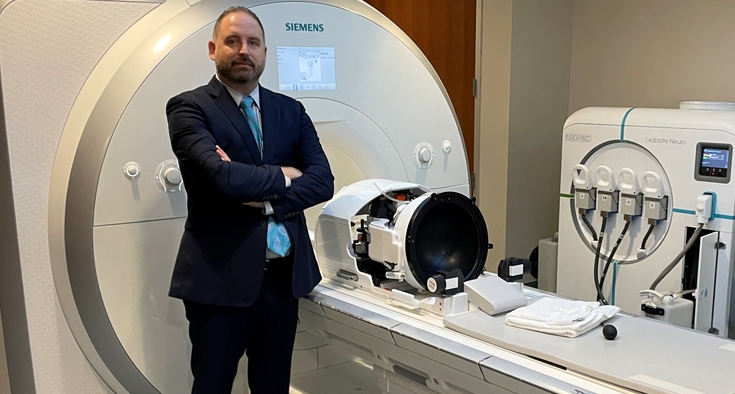When the Novant Health Neurosciences Institute - New Hanover opened February 2023, it was heralded as state-of-the-art.
That wasn’t hyperbole.
Specially trained doctors, the latest technology and cutting-edge treatments equal potentially life-changing – and life-saving – impacts for patients with neurological disorders, including brain tumors.
“We treat with between 100 and 120 brain tumors a year,” said Dr. Jeffrey Beecher, director of neurosurgery for the Coastal region of Novant Health at New Hanover Regional Medical. “The most common one we see, unfortunately, is glioblastoma. Often, patients are told at diagnosis they might have 18 months to live.”
But life-prolonging treatments are available in Wilmington. Patients require surgery, chemotherapy and radiation to treat these tumors, but advancements in surgery have finally happened after decades of research.
One is Gleolan – a drug that patients drink. It enters the patient’s bloodstream and, Beecher said, “when we go into the OR and I turn on a fluorescent filter on my microscope – actually, a sophisticated, robotic exoscope – tumors show up pink on the screen, while regular brain doesn’t.”
An exoscope is a high-definition, digital imaging system that shows surgeons a magnified, 3D image. There are only 12 in the entire country, Beecher said. Two of them are at New Hanover.
They allow us to be much more aggressive with treatment,” he added. “We can readily find the borders of the tumor, while minimizing neurologic injury.
The institute’s first floor is dedicated to Brainlab Digital ORs, which Beecher calls “the most sophisticated OR you can have for neurosurgery. It puts all our imaging, navigation and technology on floating screens on the wall. Images of everything we’re doing are everywhere.”
In addition, a neurological catheterization lab has two suites with rotating cameras that can recreate 3-D views of blood vessels leading to, and within, the brain.
Delicate and intricate
Minimally invasive techniques are part of the trailblazing treatment offered here. One involves inserting a small probe into the brain to minimize injury to the surrounding brain. It’s especially useful for very deep-seated lesions.
Laser interstitial thermal therapy is as minimally invasive as it gets. That’s when surgeons use a “high-speed drill through an incision that’s about 5 millimeters – smaller than the width of my pinkie to allow access for the probe that is gently inserted into the brain,” Beecher said.
“Then we guide a probe down to the lesion. The anesthetized patient is placed in the MRI machine, and we use heat to basically cook the tumor. We can see how much heat is being transmitted and know what areas have already reached cell death.”
“Patients with glioblastoma or metastatic cancers do very well with this,” he added.
The most complex surgeries performed are for skull base brain tumors, Beecher said. They include minimally invasive, transsphenoidal approaches, typically used for benign tumors like meningiomas, which compress the brain stem and are often difficult to reach.
“Our mantra in skull base surgery is: You take the bone away from the brain, not the brain away from the bone,” Beecher said. “These procedures involve a lot of drilling – and patience – to reach the tumor and take it away from the brain safely. Since these are benign tumors in a patient likely to live a long life, you don’t want them suffering any neurologic deficits.”
Up for the challenge
Beecher recently operated on a 23-year-old with a blood vessel tumor called a cavernoma. “This tumor was very, very deep in her brain,” he said. “We discussed her case at multiple conferences, where some neurosurgeons said we shouldn’t operate. But most agreed we should.”
He added, “I never make that decision for the patient. I educate them on their options, and then we decide together. This 23-year-old has a lot of life ahead. She didn’t want to spend the next 40, 60, 80 years wondering if she's going to have a devastating, or fatal, brain hemorrhage. She wanted it out.”
The operation went “fantastically well, and she went home about four days after surgery.”
‘True team approach’
A neuro-oncology advanced practice provider (APP) recently joined the institute to lead that multidisciplinary service line. “That really helps tie in our brain tumor program with radiation oncology, medical oncology and neurosurgery,” Beecher said. “We offer patients a true team approach – which they deserve.”
While clinical trials are not offered (yet) at New Hanover, clinicians can help patients get into trials elsewhere. One had been enrolled in a trial Beecher is particularly excited about – for SurVaxM, an innovative immunotherapy for glioblastoma – but had to leave when her blood levels dropped.
“There’s a lot of interest in that trial,” Beecher said. “SurVaxM could be a breakthrough. We may have our first real advancement in a nonsurgical modality for glioblastoma.”
And advancement is what this institute is becoming known for.
Patients with extremely challenging tumors are frequently referred here. The team is ready to welcome anyone with a brain tumor or other neurological condition to their high-tech home and, when deemed appropriate, their revolutionary OR.
When it comes to brain tumors, high-tech means hope.
If you have a patient with a brain tumor – malignant or benign – and want to offer them the latest treatments and technology, consider a referral to Novant Health Neurosciences Institute
Charlotte 704-316-3079
Winston-Salem 336-765-6637
Wilmington 910-667-6039







